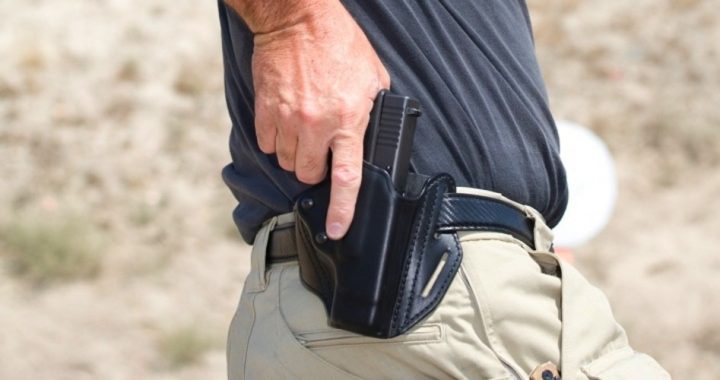
On April 2, Kansas Governor Sam Brownback signed a bill into law expanding the state’s permitless open-carry laws to include concealed carry. The concealed carry permitting process will remain in place for citizens who wish to travel to other reciprocity states where that concealed carry permit allows them to carry concealed there.
Chris Cox, executive director of the National Rifle Association (NRA), declared, “This new law is a common sense measure that allows law-abiding Kansans to exercise their fundamental right to self-protection in the manner that best suits their needs.”
Kansans already had the right to carry a firearm openly without a permit, but if that firearm was covered by a shirt or a jacket, or carried in a purse, the citizen would need a concealed carry permit. Effective July 1, no such permit will be necessary.
Last year, Kansas enacted a law prohibiting local municipalities from passing laws restricting gun sales or ownership or open carry. In 2013 the state passed a law declaring that the federal government had no authority in the state to regulate firearms that were manufactured, sold, and owned only in Kansas, and prohibiting Kansans’ tax dollars from promoting gun-control policies.
Often referred to as “constitutional carry” or “Vermont carry,” permitless carry satisfies most purists who take the language of the Second Amendment literally: “… the right to keep and bear arms shall not be infringed.” With its hands-off policy, Kansas joins a growing number of states with similar freedoms, including Alaska, Arizona, Vermont, and Wyoming.
Alaska’s law dates back to 2003, while Arizona’s took effect in August, 2013. Vermont has stood virtually alone until relatively recently, with its history of permitless or constitutional carry dating back to the creation of the Union. Wyoming’s law dates to 2011 when Governor Matt Mead signed into law legislation giving the state’s citizens the right to carry openly or concealed without a permit.
Open carry without a permit is also legal in Alabama, Arkansas, Colorado, Delaware, Idaho, Kentucky, Louisiana, Maine, Michigan, Mississippi, Montana, Nevada, New Mexico, North Carolina, Ohio, South Dakota, Oklahoma, Virginia, Washington, and Wisconsin. Surprisingly, the open carry of a handgun is prohibited in Texas.
Naturally, with laws favoring the Second Amendment being passed so rapidly, readers are advised to check local laws before travelling to reciprocity states. One website that was just updated on April 2 is Handgunlaw.us, which issued this warning:
While we have made every possible effort to insure these maps and information [the website is interactive with links to the laws in every state] are accurate as of [April 2], it is your responsibility to verify the data offered.
Contrast this with the efforts of Sarah Brady — chairwoman of both the anti-gun Brady Campaign to Prevent Gun Violence [formerly Handgun Control, Inc.] and the Brady Center — who died the day after Governor Brownback signed the Kansas billl into law.
Ms. Brady, the wife of President Reagan’s Press Secretary James Brady, who in 1981 was shot by John Hinckley, offered her assistance to Handgun Control, Inc. in 1985. In 1993, then-President Bill Clinton signed the Brady Handgun Violence Prevention Act into law, mandating background checks and waiting periods for many gun purchasers. One year later Clinton signed into law the Federal Assault Weapons Ban.
By the time that ban expired in 2004, despite heroic efforts to renew it, the attitude of the American people had shifted to such an extent that it was the last major anti-gun piece of legislation to have passed at the federal level. Since then the battles, with rare exceptions, have been won by pro-gun, pro-Second Amendment forces. Today the Brady Campaign and its affiliate, the Brady Center, claim 600,000 members with a budget of slightly more than $3 million a year.
On the other hand, the National Rifle Association, by itself, dwarfs the Brady effort, with more than five million members and an annual budget exceeding $250 million. This doesn’t count the myriad other pro-Second Amendment groups such as the Second Amendment Foundation, Gun Owners of America, Jews for the Preservation of Firearms Ownership, and the National Association for Gun Rights.
Early on, gun-control advocates ruled the day. The first major infringement on gun rights occurred with passage of the National Firearms Act in 1934. It was followed in 1968 by the Omnibus Crime Control and Safe Streets and the Gun Control Acts of 1968. Since the expiration of the Federal Assault Weapons Ban in 2004, the shift favoring gun ownership has been nearly tectonic. With irrefutable evidence that gun ownership results in less crime (according to the NRA, since permitless carry was adopted, murder rates in Alaska have declined by 23 percent, in Arizona by 16 percent, and in Wyoming by eight percent) thanks to efforts by John Lott (author of More Guns, Less Crime) and others, the shift toward self-reliance and individual responsibility continues apace.
Like two ships passing in the night, the Brady Campaign and the pro-Second Amendment movement are heading in opposite directions. It’s clear at which ship has the greater momentum and velocity at this time.
A graduate of an Ivy League school and a former investment advisor, Bob is a regular contributor to The New American magazine and blogs frequently at www.LightFromTheRight.com, primarily on economics and politics.



